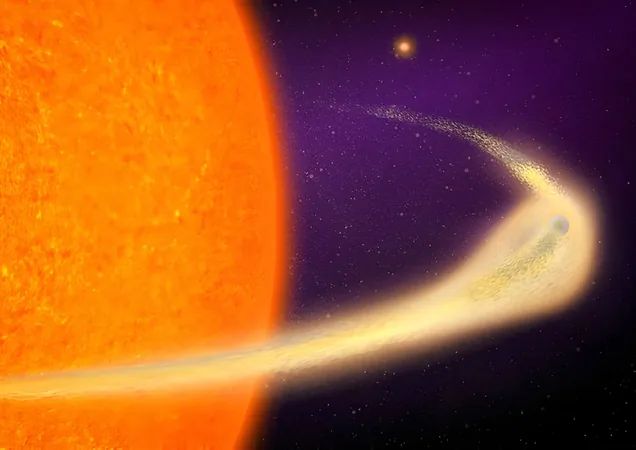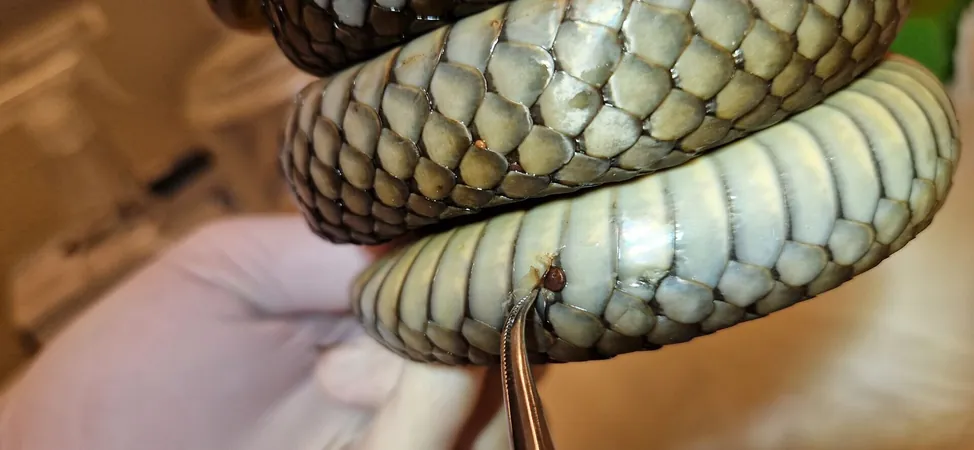
Astronomers Witness a Dying Exoplanet Disintegrating into Cosmic Dust!
2025-04-26
Author: Ming
Astronomers have made a jaw-dropping discovery: an exoplanet about 140 light-years away is rapidly disintegrating, creating an astounding tail of dust as it spirals through space. This fascinating phenomenon was identified by NASA's Transiting Exoplanet Survey Satellite (TESS), which recorded abnormal fluctuations in the brightness of the star this exoplanet orbits.
Meet BD+05 4868 Ab: The Exoplanet with a Dust Tail!
The planet in question, dubbed BD+05 4868 Ab, completes its orbit in a mere 30 hours. Located perilously close to its host star, it endures scorching temperatures that can melt rock, causing it to shed its outer layers. The result is an impressive tail stretching up to a staggering 9 million kilometers (5.6 million miles) long, reminiscent of a comet’s dusty trail.
Unraveling the Mystery of Dust Clouds
Dr. Marc Hon from MIT explains that this dust cloud isn’t static; it evolves over time, leading to the peculiar variations in starlight that TESS observed. Unlike typical patterns from orbiting bodies, the inconsistent signals hint at a continuous release of dust that changes with each cycling orbit.
The Exoplanet's Extraordinary Mass Loss
As BD+05 4868 Ab whirls around its star, it loses the mass equivalent of an entire mountain every orbit. If this disintegration persists, this small planet could completely vanish in just a few million years! Avi Shporer from the TESS Science Office remarked how fortunate researchers were to catch the planet in its dramatic downfall.
Habitat Destruction: Extreme Conditions at Play
This crumbling exoplanet showcases the extreme conditions that can lead to such phenomena. Its proximity to the star subjects it to severe radiation, which plays a critical role in its continual mass loss. Typically, larger rocky planets can retain their minerals, but this tiny world simply doesn’t have the gravitational strength to hold on when faced with such relentless heat.
A Rare Cosmic Discovery
Only a few exoplanets show signs of such violent disintegration, making BD+05 4868 Ab a remarkable case study for astronomers. The unique brightness of its host star allows for clearer observations and deeper insights into the dust’s composition.
Looking Ahead: Future Research and Discoveries!
Excitingly, scientists plan to utilize the James Webb Space Telescope to further investigate this cosmic matchup. By analyzing the infrared signatures of the dust emitted by BD+05 4868 Ab, researchers aim to decode the planet's mineral composition, which could reveal fascinating comparisons with the rocky planets of our own solar system.
Despite its impending demise, BD+05 4868 Ab's disintegration offers a unique lens through which astronomers can study planetary life cycles and the engaging dynamics between stars and their orbiting planets.
This groundbreaking study has been published in The Astrophysical Journal Letters, illuminating the universe’s mysterious and ever-changing nature.




 Brasil (PT)
Brasil (PT)
 Canada (EN)
Canada (EN)
 Chile (ES)
Chile (ES)
 Česko (CS)
Česko (CS)
 대한민국 (KO)
대한민국 (KO)
 España (ES)
España (ES)
 France (FR)
France (FR)
 Hong Kong (EN)
Hong Kong (EN)
 Italia (IT)
Italia (IT)
 日本 (JA)
日本 (JA)
 Magyarország (HU)
Magyarország (HU)
 Norge (NO)
Norge (NO)
 Polska (PL)
Polska (PL)
 Schweiz (DE)
Schweiz (DE)
 Singapore (EN)
Singapore (EN)
 Sverige (SV)
Sverige (SV)
 Suomi (FI)
Suomi (FI)
 Türkiye (TR)
Türkiye (TR)
 الإمارات العربية المتحدة (AR)
الإمارات العربية المتحدة (AR)